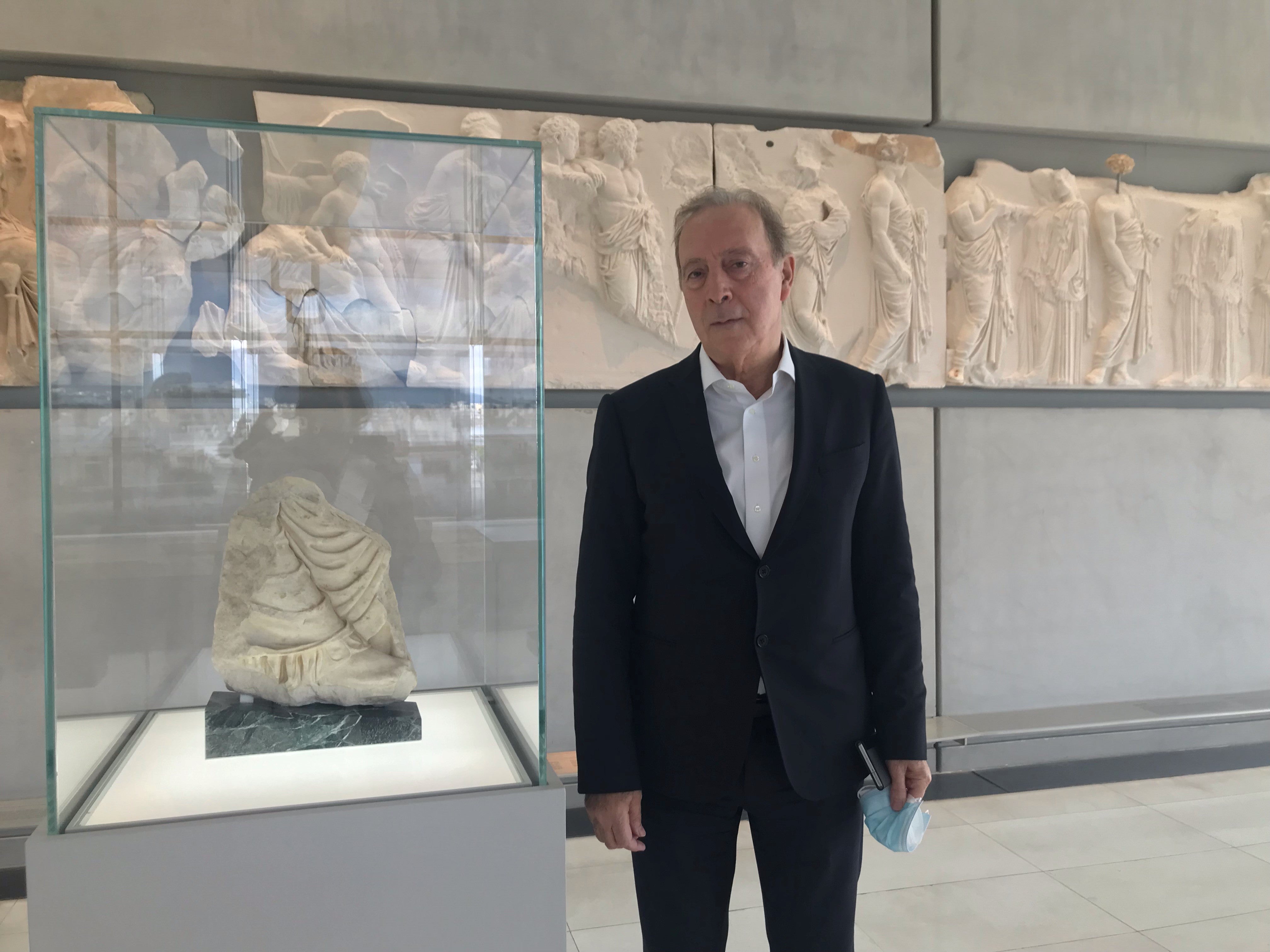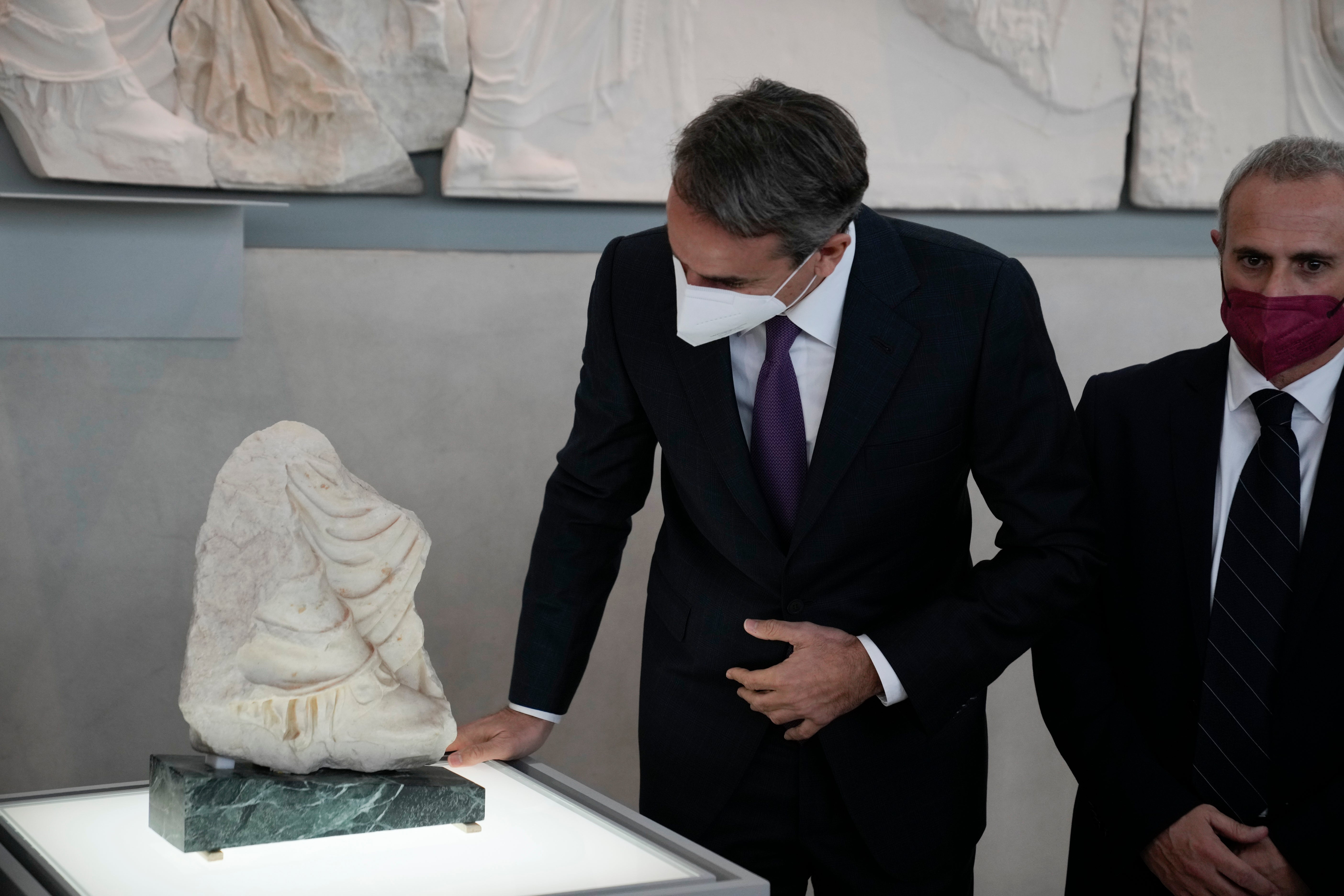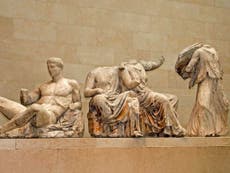How a small marble foot has put more pressure on the British Museum to return the Elgin marbles
The return to Greece of a marble fragment from Italy has shifted attention to other artefacts that could – or should – be returned, reports Moira Lavelle

On its own, the marble fragment is modest – the size of a child’s backpack.
It shows a right foot draped with diaphanous fabric. The foot belongs to the goddess Artemis, and is part of the monumental 158 metre (518 feet) Ionic frieze depicting mortals and gods of ancient Greece on the inner layer of the Parthenon temple in Athens.
The marble piece has spent decades in the Antonino Salinas Regional Archaeological Museum in Palermo, Sicily. In a landmark deal this week, it was sent to Greece in exchange for an ancient statue and an amphora.
Most of the remainder of the frieze is currently in the British Museum, and the move by Italy is seen by many as putting more pressure on the British to return the artefacts to Greece, reigniting one of the art world’s most heated and long-running disputes.
“The whole debate has really struck a chord,” said Greece’s prime minister, Kyriakos Mitsotakis, who attended a ceremony to welcome the fragment. “I do sense there is a momentum building, and of course, the elephant in the room is the discussion we will have to have with the British Museum.”
Currently 15 of the Parthenon’s metope sculptures, 17 pedimental figures, and large parts of the north and south friezes are in the British Museum. Starting in 1801, Lord Elgin, then British ambassador to the Ottoman empire, sliced these pieces from their bases, and in 1816 he sold them to the museum, where they have been displayed since.
The newly welcomed fragment from Italy was sold to the museum in Sicily from the collection of late-1800s British diplomat Robert Fagan, though it’s not clear how he acquired it.
The director of the Acropolis Museum, Nikolaos Stampolidis, underlines that the fragment is not on loan.
“I would never sign any contract with the term ‘loan’. A loan means that I understand that the possession of the other is legal, and this is not the case,” he says.
Rather, the artefact is on deposit for eight years, and Sicily has stated it will request that the Italian ministry of culture make the move permanent. “We think this is the way the British government should go forth,” says Stampolidis.
Greece has been requesting that Britain return the Parthenon marbles for almost 200 years.
In the past year, the debate has again risen to the surface. In October, a Unesco advisory board officially recommended that the British Museum renew its position. A month later, the Greek prime minister visited Boris Johnson and again requested the return of the marbles. Johnson, like his predecessors, demurred, saying that the issue was one for the British Museum.
For its part, the British Museum has maintained that the marbles are not moving. The museum states that Lord Elgin obtained a legal permit from the relevant authorities to remove the marbles, and that his actions were investigated and determined to be above board by a parliamentary committee prior to their purchase.
The Greek side has responded that the permit Elgin received didn’t allow for the removal of sculptural decorations, and that regardless, permission from an occupying power has no legal standing.

“Most of the nations or institutions that are keeping these things will say, ‘Well, under the laws of the time there was nothing illegal.’ Except that there were no international laws under the context of colonialism. Once you say you bought it, it implies you could have competent partners under the context of colonialism, which I don’t think is the case,” says Chika Okeke-Agulu, director of Princeton’s programme in African studies and a professor of art history.
Mr Okeke-Agulu has been vocal in calling for museums around the world to return the Benin bronzes – a collection of thousands of cultural materials looted by the British military from the palace of the king of Benin in the late 1800s and later sold throughout Europe – and other cultural artefacts.
Though the requests for repatriation of cultural artefacts are not new, in recent years countries have been increasingly asked to return items taken during colonial times.
Some have listened. In November 2021, France agreed to return 26 artefacts to Benin. The German government announced in April that it would begin repatriating its collection of Benin bronzes. New York’s Metropolitan Museum stated in October that it would return a 10th-century Hindu sculpture of Shiva to Nepal, and in June that it would return two Benin bronzes from its collection.
Many of the repatriation requests, however, are not met with such equanimity. The British Museum’s principal argument against returning the Parthenon sculptures is that it is a global museum. A statement from the museum said: “The museum takes its commitment to be a world museum seriously. The collection is a unique resource to explore the richness, diversity and complexity of all human history, our shared humanity.”
Mr Okeke-Agulu is not convinced: “What these institutions are saying is they have the right to hoard the world’s heritage.
“We should talk about sharing the world’s artefacts, not hoarding them. I would like to see these same kinds of global museums not just in London and New York, but in Lagos, in Singapore, in Delhi, in Johannesburg.”
In 2009, Greece built a massive state-of-the art Acropolis museum. The top floor of the museum displays the outer doric frieze and the inner ionic frieze on a scale model with a parallel view of the Parthenon itself. Plaster casts hold the place of every fragment currently held by the British Museum.

Mr Stampolidis sees the reunification of these pieces as integral: “It’s not a free-standing sculpture that has been brought away. It is the body of the monument itself that asks [for] its members back.”
This argument has been echoed throughout the archaeological and museum world.
“My point is about the integrity of the monument. In Palermo [the fragment] was on the wall in the museum. It sits there and it’s kind of meaningless to people, because it’s a marble foot. And even if you tell them it’s from Artemis from the Parthenon, they can’t picture it,” says Jenifer Neils, director of the American School of Classical Studies at Athens and author of The Parthenon Frieze.
Mr Stampolidis argues that for this reason, the calls for the Parthenon marbles to be returned are not the same as calls for the repatriation of other items. The Parthenon is a sui generis – in a class by itself.
Inside the museum, Mr Stampolidis points to a chunk of the south frieze that Elgin’s workers cleaved off: “Look what he has done,” he says. A 3D illustrated video shows how Elgin used crowbars to pull the friezes down. Several times, Mr Stampolidis repeats the ancient Greek phrase: ο τρώσας και ιάσεται, meaning “He that wounded shall heal”.
This article was corrected on 17 January 2022 to note that the artefact is on deposit for eight years, not four years as first stated.






Join our commenting forum
Join thought-provoking conversations, follow other Independent readers and see their replies
Comments